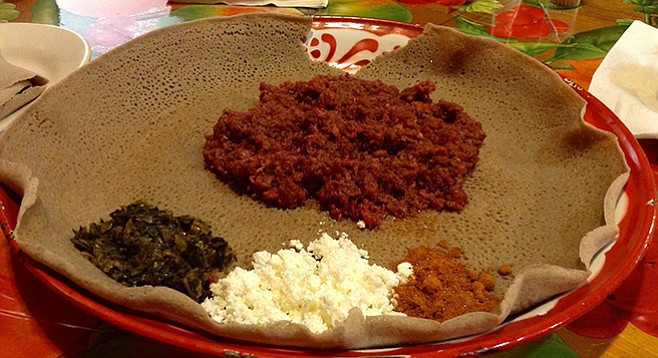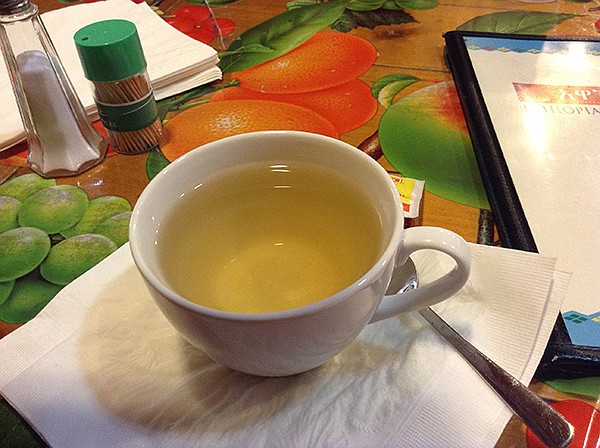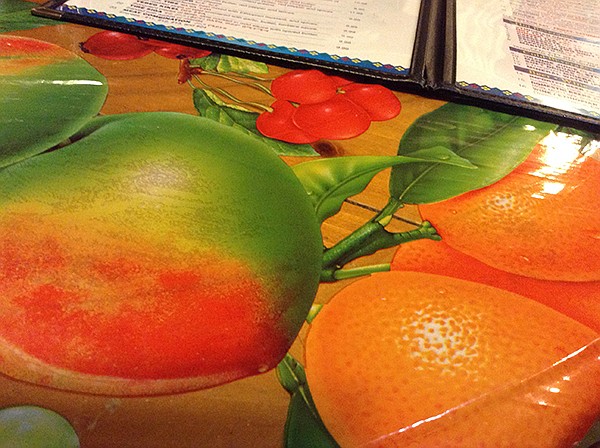 Facebook
Facebook
 X
X
 Instagram
Instagram
 TikTok
TikTok
 Youtube
Youtube


"Yes,” says Habtamu. “This bread is two days old.”
Okay, sounds like a confession. But, no, it’s a statement of pride.
“Our bread,” he says, “needs time.”
We’re talking injera, the famous Ethiopian bread that looks like a giant lily pad. Or a way-big crumpet. And functions like a plate. In Ethiopia you eat your plate. In preparing, you’ve got to allow two days for it to ferment and rise, Habtamu says.
“That gives it its slightly bitter flavor and spongey texture.”
Mine has a pile of nearly raw ground meat on it surrounded by ayib (Ethiopian white cheese), collard greens, and an orange serrano pepper mix, each in its own little pile. The whole injera “plate” looks like an artist’s palette, with splotches of paint scattered around it. You hate to break it up. And you don’t have to, at first. They have a separate plate of three rolled-up injera to rip off and grip mouthfuls of meat and spices with. In your right hand, of course. And it’s supposed to be really good for you, if it’s made with teff, the Ethiopian grain that’s packed full of iron.
I had wandered into what looked like a grocery store up here at 30th and ECB. It’s Ethiopian. “Awash.” Easy to remember because it’s named after a river.

“You guys have a, like, sit-down eatery?” I ask this gent at the cashier’s desk.
“Oh, yes,” he says, like he’s a bit surprised that I don’t know. “In the back.”
This is Habtamu. He leads me through the rows of spices and canned food to a room with maroon walls, white drapes, a giant screen showing hoop games, and four tables covered in bright fruit-photo plastic tablecloths.
He gets me a cup of hot tea. Oh, yes. Clears the palate. Try to remember what I know about Ethiopian food. Stews, mainly, and injera, right?
I check the menu, but I don’t recognize anything. T’ibs? Marinated meat cubes ($9.99). Yedero wot? Chicken with berbere sauce ($9.99). Gored gored, lightly cooked beef with Ethiopian mustard ($9.99). But the list goes on. Zilzil tibs, yebeg kikel, minchet abish wot… I’m all alone at sea.

“How about a kitfo?” asks Habtamu. He has come and sat down at the next table. “That’s one of our most famous dishes. It’s like steak tartare, but I like it lightly cooked, rare, leb leb, as we say.”
I check the menu. “…seasoned with butter, red pepper, spices, served with Ethiopian cheese, $9.99.”
Hmm... So I ask for it, and when it comes, it’s this way-big injera on a metal tray, with a big splot of hot kitfo (“chopped meat”) in the middle, and piles of ayib, the Ethiopian white cheese (basically milk that’s been boiled, curdled, mixed with lemon), collard greens, and an orange serrano pepper mix, each in a neat pile on the fermented bread. Plus the extra injera rolls. I start ripping the spongey bread off, and squeezing it around the meat. Really savory. Habtamu says the collard greens came across to the American colonies from Africa and were originally from the eastern Mediterranean. “They are one of the most ancient vegetables in the world,” he says. “From prehistoric times.”
So, I had asked for the kitfo to be hot, spicy-hot. And it is, especially when you mix the serrano sauce in. That’s why the curdled milk cheese is so refreshing between the hits of heat. What I love is the hands thing: ripping off spongey flappers of the stuff, then close-wrapping them around the meat. The beautiful thing is the injera soaks up the flavors of whatever it’s gripping, so you seem to get a double dose of the taste.

“So, would the kitfo be the same in Addis Ababa [Ethiopia’s capital] as what we’re eating here?” I ask Habtamu.
“I think so, but…” He gets up and a moment later, he’s back with an older man. “Michael knows this better. He has been back there much more than I.”
Turns out Michael comes here just about every day to eat.
“This food is real,” Michael says. “The only difference is what you get here is the basic recipes. Addis is a very social town. Thousands of cafés. Always packed. And at each you’d get the cook’s own variations of dishes like kitfo. And on our fast days, usually Wednesday and Friday each week, people eat only vegan food. No meat. So, we have a huge selection of vegetables to make the food interesting. And also the tastes there are more intense. It’s because the food has always been organic. No speeding up growth, no fertilizers. Except now our government is trying to force fertilizers on us in Ethiopia. And soon, GMO. We don’t have a McDonald’s, but it is only a matter of time.”
“So, what three Ethiopian foods would you choose if you were going to be stuck on a desert island for the rest of your life?”
Michael thinks a moment.

“First, the doro wat. Chicken stew. With injera, of course. You share it. So, I hope I’d have friends on the island. Second, I’d have kitfo, like you’re having; and, third, I’d have shiro, basically ground chickpeas. It’s vegetarian, and it’s the comfort food of my childhood. My mother always made it for me.”
Turns out he’s flying back home to Addis in three weeks. He’s going back to visit the almost mythological city of Axum. Why? “Because that is where the Ark of the Covenant is,” he says. “It is very holy. Monks guard it. Ethiopia has the most ancient Christianity.”
I make a private note: gotta go there. I make a second one. Gotta come back and try the shiro here. Apart from everything else, it’s only $6.55, just about the cheapest item on the menu. For comfort food, that’s a comforting price.
Prices: Breakfast foul (crushed beans, Ethiopian butter, onion, tomato, French bread), $6.99; sambusa (meat or lentil), $1.50; kitfo (ground beef with butter, red pepper, spices, collard greens, $9.99; gored gored, beef with Ethiopian mustard, $9.99; yebeg t’ibs (lamb sautéed with onions, jalapeños), $10.99; meat combination, $9.99; Ethiopian coffee, $2
Hours: 9:00 a.m.–01:00 a.m. daily
Buses: 1, 2, 6, 215
Nearest bus stop: El Cajon Boulevard and 30th Street



"Yes,” says Habtamu. “This bread is two days old.”
Okay, sounds like a confession. But, no, it’s a statement of pride.
“Our bread,” he says, “needs time.”
We’re talking injera, the famous Ethiopian bread that looks like a giant lily pad. Or a way-big crumpet. And functions like a plate. In Ethiopia you eat your plate. In preparing, you’ve got to allow two days for it to ferment and rise, Habtamu says.
“That gives it its slightly bitter flavor and spongey texture.”
Mine has a pile of nearly raw ground meat on it surrounded by ayib (Ethiopian white cheese), collard greens, and an orange serrano pepper mix, each in its own little pile. The whole injera “plate” looks like an artist’s palette, with splotches of paint scattered around it. You hate to break it up. And you don’t have to, at first. They have a separate plate of three rolled-up injera to rip off and grip mouthfuls of meat and spices with. In your right hand, of course. And it’s supposed to be really good for you, if it’s made with teff, the Ethiopian grain that’s packed full of iron.
I had wandered into what looked like a grocery store up here at 30th and ECB. It’s Ethiopian. “Awash.” Easy to remember because it’s named after a river.

“You guys have a, like, sit-down eatery?” I ask this gent at the cashier’s desk.
“Oh, yes,” he says, like he’s a bit surprised that I don’t know. “In the back.”
This is Habtamu. He leads me through the rows of spices and canned food to a room with maroon walls, white drapes, a giant screen showing hoop games, and four tables covered in bright fruit-photo plastic tablecloths.
He gets me a cup of hot tea. Oh, yes. Clears the palate. Try to remember what I know about Ethiopian food. Stews, mainly, and injera, right?
I check the menu, but I don’t recognize anything. T’ibs? Marinated meat cubes ($9.99). Yedero wot? Chicken with berbere sauce ($9.99). Gored gored, lightly cooked beef with Ethiopian mustard ($9.99). But the list goes on. Zilzil tibs, yebeg kikel, minchet abish wot… I’m all alone at sea.

“How about a kitfo?” asks Habtamu. He has come and sat down at the next table. “That’s one of our most famous dishes. It’s like steak tartare, but I like it lightly cooked, rare, leb leb, as we say.”
I check the menu. “…seasoned with butter, red pepper, spices, served with Ethiopian cheese, $9.99.”
Hmm... So I ask for it, and when it comes, it’s this way-big injera on a metal tray, with a big splot of hot kitfo (“chopped meat”) in the middle, and piles of ayib, the Ethiopian white cheese (basically milk that’s been boiled, curdled, mixed with lemon), collard greens, and an orange serrano pepper mix, each in a neat pile on the fermented bread. Plus the extra injera rolls. I start ripping the spongey bread off, and squeezing it around the meat. Really savory. Habtamu says the collard greens came across to the American colonies from Africa and were originally from the eastern Mediterranean. “They are one of the most ancient vegetables in the world,” he says. “From prehistoric times.”
So, I had asked for the kitfo to be hot, spicy-hot. And it is, especially when you mix the serrano sauce in. That’s why the curdled milk cheese is so refreshing between the hits of heat. What I love is the hands thing: ripping off spongey flappers of the stuff, then close-wrapping them around the meat. The beautiful thing is the injera soaks up the flavors of whatever it’s gripping, so you seem to get a double dose of the taste.

“So, would the kitfo be the same in Addis Ababa [Ethiopia’s capital] as what we’re eating here?” I ask Habtamu.
“I think so, but…” He gets up and a moment later, he’s back with an older man. “Michael knows this better. He has been back there much more than I.”
Turns out Michael comes here just about every day to eat.
“This food is real,” Michael says. “The only difference is what you get here is the basic recipes. Addis is a very social town. Thousands of cafés. Always packed. And at each you’d get the cook’s own variations of dishes like kitfo. And on our fast days, usually Wednesday and Friday each week, people eat only vegan food. No meat. So, we have a huge selection of vegetables to make the food interesting. And also the tastes there are more intense. It’s because the food has always been organic. No speeding up growth, no fertilizers. Except now our government is trying to force fertilizers on us in Ethiopia. And soon, GMO. We don’t have a McDonald’s, but it is only a matter of time.”
“So, what three Ethiopian foods would you choose if you were going to be stuck on a desert island for the rest of your life?”
Michael thinks a moment.

“First, the doro wat. Chicken stew. With injera, of course. You share it. So, I hope I’d have friends on the island. Second, I’d have kitfo, like you’re having; and, third, I’d have shiro, basically ground chickpeas. It’s vegetarian, and it’s the comfort food of my childhood. My mother always made it for me.”
Turns out he’s flying back home to Addis in three weeks. He’s going back to visit the almost mythological city of Axum. Why? “Because that is where the Ark of the Covenant is,” he says. “It is very holy. Monks guard it. Ethiopia has the most ancient Christianity.”
I make a private note: gotta go there. I make a second one. Gotta come back and try the shiro here. Apart from everything else, it’s only $6.55, just about the cheapest item on the menu. For comfort food, that’s a comforting price.
Prices: Breakfast foul (crushed beans, Ethiopian butter, onion, tomato, French bread), $6.99; sambusa (meat or lentil), $1.50; kitfo (ground beef with butter, red pepper, spices, collard greens, $9.99; gored gored, beef with Ethiopian mustard, $9.99; yebeg t’ibs (lamb sautéed with onions, jalapeños), $10.99; meat combination, $9.99; Ethiopian coffee, $2
Hours: 9:00 a.m.–01:00 a.m. daily
Buses: 1, 2, 6, 215
Nearest bus stop: El Cajon Boulevard and 30th Street